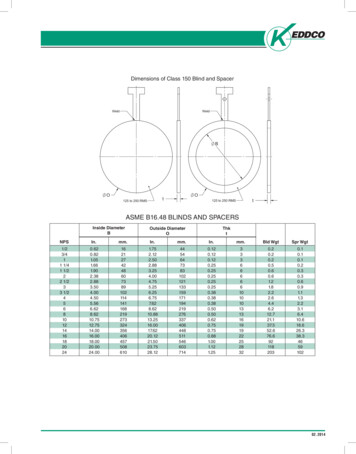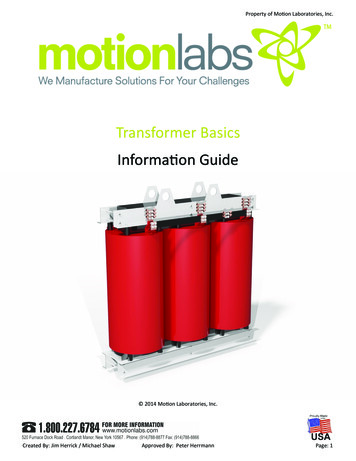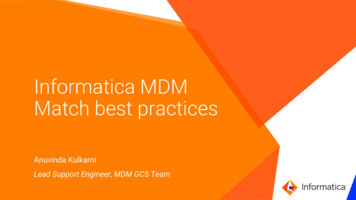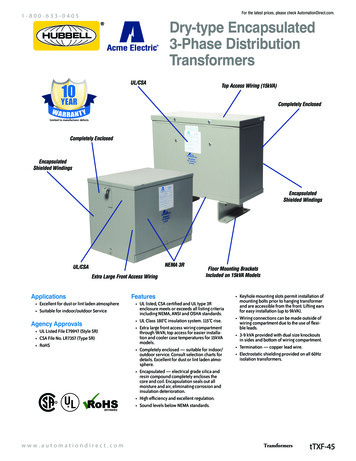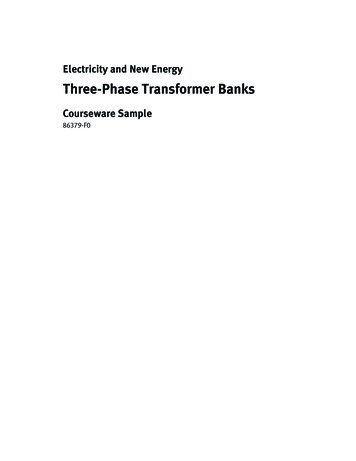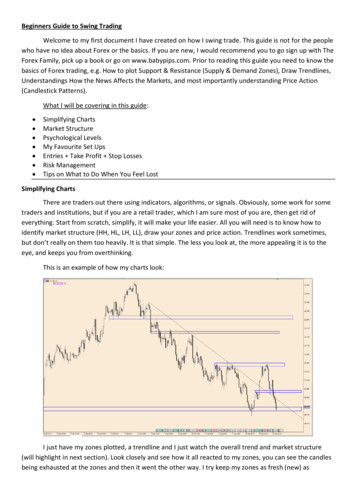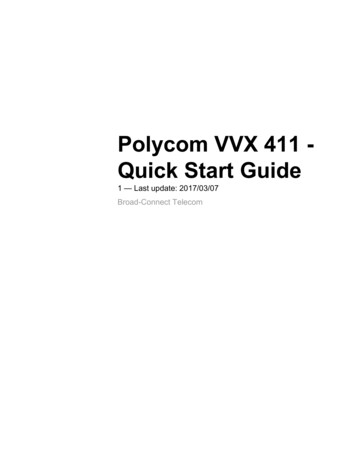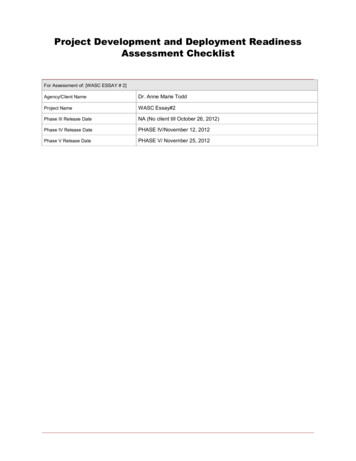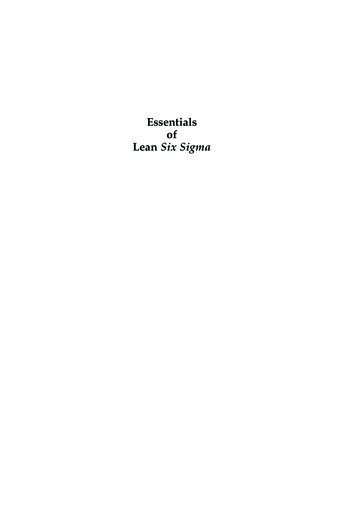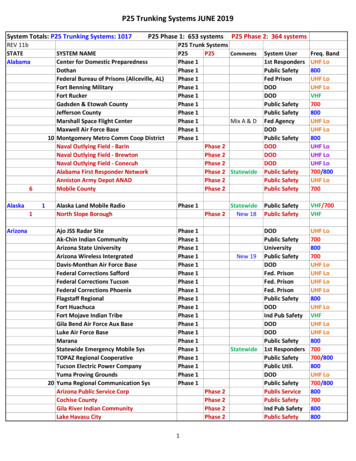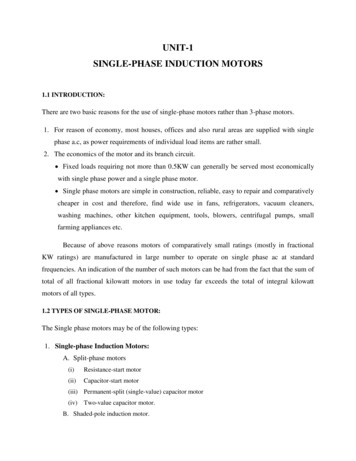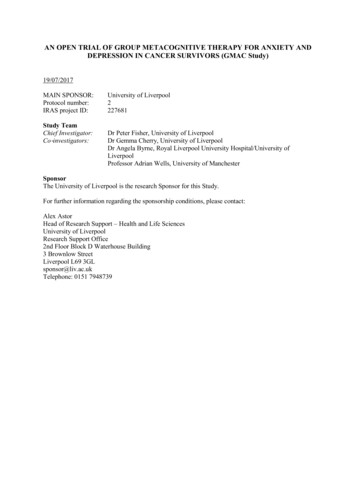
Transcription
DMID Protocol #14-0079Version 4.0SCOUT-CAP14 December 2018A Phase IV Double-Blind, Placebo-Controlled, Randomized Trial to EvaluateShort Course vs. Standard Course Outpatient Therapy ofCommunity Acquired Pneumonia in Children (SCOUT-CAP)DMID PROTOCOL NUMBER: 14-0079DMID FUNDING MECHANISM: VACCINE AND TREATMENT EVALUATION UNITIND SPONSOR: NIH/NIAID/DMIDVTEU PRINCIPAL INVESTIGATOR: C. BUDDY CREECH, MD, MPHARLG PRINCIPAL INVESTIGATORS: W. CHARLES HUSKINS, MD, MSC& THEOKLIS ZAOUKIS, MD, MCSEVERSION NUMBER: 4.014 DECEMBER 2018i
DMID Protocol #14-0079Version 4.0SCOUT-CAP14 December 2018STATEMENT OF COMPLIANCEThis trial will be carried out in accordance with Good Clinical Practices (GCP) as required by thefollowing: United States Code of Federal Regulations (CFR) applicable to clinical studies (45 CFRPart 46; 21 CFR Part 50, 21 CFR Part 54, 21 CFR Part 56, and 21 CFR Part 312); International Conference on Harmonization (ICH) E6; 62 Federal Register 25691 (1997); The Health Insurance Portability and Accountability Act (HIPAA) Privacy Rule-FinalModification (45 CFR Parts 160 and 164); National Institutes of Health (NIH) Clinical Terms of Award, as applicable.Compliance with these standards provides public assurance that the rights, safety and wellbeing of study subjects are protected, consistent with the principles that have their origin in theDeclaration of Helsinki.All key personnel (all individuals responsible for the design and conduct of this trial) havecompleted Human Subjects Protection Training.ii
DMID Protocol #14-0079Version 4.0SCOUT-CAP14 December 2018SIGNATURE PAGEThe signature below constitutes the approval of this protocol and the attachments, and providesthe necessary assurances that this trial will be conducted according to all stipulations of theprotocol, including all statements regarding confidentiality, and according to local legal andregulatory requirements and applicable United States of America (US) federal regulations andICH guidelines.Site Principal Investigator SignatureDate:iii
DMID Protocol #14-0079Version 4.0SCOUT-CAP14 December 2018TABLE OF CONTENTSPageStatement of Compliance . iiSignature Page . iiiTable of Contents. ivList of Figures and Tables . viiList of Abbreviations . viiiProtocol Summary . ix1Key Roles .112Background Information and Scientific Rationale. 132.1Background Information .132.2Rationale .132.3Potential Risks and Benefits .142.3.1 Potential Risks .142.3.2 Known Potential Benefits.143Objectives .153.1Study Objectives .153.2Study Outcome Measures .153.2.1 Primary Outcome Measures .153.2.2 Secondary Outcome Measures .173.2.3 Exploratory Outcome Measures .184Study Design .195Study Enrollment and Withdrawal .215.1Subject Inclusion Criteria .215.2Subject Exclusion Criteria .215.3Treatment Assignment Procedures .235.3.1 Randomization Procedures .235.3.2 Masking Procedures.235.3.3 Reasons for Withdrawal .245.3.4 Handling of Withdrawals .255.3.5 Termination of Study .256Study Intervention/Investigational Product .266.1Study Product Description .266.1.1 Acquisition .266.1.2 Formulation, Packaging, and Labeling. 266.1.3 Product Storage and Stability .286.2Dosage, Preparation and Administration of Study Intervention/InvestigationalProduct .296.2.1 Dosage.296.2.2 Preparation .296.2.3 Administration .296.3Modification of Study Intervention/Investigational Product for a Participant . 29iv
DMID Protocol #14-0079Version 4.0SCOUT-CAP14 December 20186.46.57891011Accountability Procedures for the Study Intervention/Investigational Product(s) . 30Assessment of Subject Compliance with Study Intervention/InvestigationalProduct .306.6Concomitant Medications/Treatments .30Study Schedule .317.1Screening .317.2Enrollment/Baseline .317.3Follow-up .337.4Final Study Visit .347.5Early Termination Visit .34Study Procedures/Evaluations.368.1Clinical Evaluations .368.2Laboratory Evaluations .378.2.1 Clinical Laboratory Evaluations .378.2.2 Special Assays or Procedures .378.2.3 Specimen Preparation, Handling, and Shipping . 37Assessment of Safety .399.1Specification of Safety Parameters .399.2Methods and Timing for Assessing, Recording, and Analyzing SafetyParameters .409.2.1 Adverse Events .409.2.2 Serious Adverse Events .409.2.3 Procedures to be Followed in the Event of Abnormal Clinical Findings . 429.3Reporting Procedures .429.3.1 Serious Adverse Events .429.3.2 Regulatory Reporting for Studies Conducted Under DMID-SponsoredIND.439.4Type and Duration of Follow-up of Subjects after Adverse Events . 439.5Halting Rules .439.5.1 Study Halting Rules .439.5.2 Individual Halting Rules (Termination of Study Product Administration). 449.6Safety Oversight .449.6.1 Data and Safety Monitoring Board (DSMB) .44Clinical Monitoring .4610.1 Site Monitoring Plan .46Statistical Considerations .4711.1 Study Hypothesis .4811.2 Sample Size Considerations .4811.3 Planned Interim Analyses .4811.3.1 Safety Review .4811.3.1 Interim Analysis of Efficacy, Futility, and Safety. 4911.4 Final Analysis Plan .5011.4.1 Primary Analysis .50v
DMID Protocol #14-0079Version 4.0SCOUT-CAP14 December 201811.4.2 Secondary Analyses.5111.4.3 Exploratory Analyses .5212 Source Documents and Access to Source Data/Documents . 5313 Quality Control and Quality Assurance .5414 Ethics/Protection of Human Subjects.5514.1 Ethical Standard .5514.2 Institutional Review Board .5514.3 Informed Consent Process .5514.3.1 Informed Consent .5514.3.2 Informed Consent/Assent Process (in Case of a Minor) . 5614.4 Exclusion of Women, Minorities, and Children (Special Populations) . 5614.5 Subject Confidentiality .5614.6 Future Use of Stored Specimens .5715 Data Handling and Record Keeping .5815.1 Data Management Responsibilities .5815.2 Data Capture Methods .5815.3 Types of Data .5815.4 Timing/Reports .5915.5 Study Records Retention .5915.6 Protocol Deviations .5916 Publication Policy .6017 Literature References .61APPENDIX A – Schedule of Evaluations.62vi
DMID Protocol #14-0079Version 4.0SCOUT-CAP14 December 2018LIST OF FIGURES AND TABLESFigure 1:Study Schematic .xTable 1. Ordinal Outcome .16Table 2: Severity of Cough .17Table 3. Solicited Events Grading .17vii
DMID Protocol #14-0079Version 4.0SCOUT-CAP14 December 2018LIST OF ITTMOPNIAIDNIHOHRPPIQAQCRADARSAESDCCAdverse Event/Adverse ExperienceAntibiotic Resistance Leadership GroupAccording-to-ProtocolCommunity Acquired PneumoniaComplete CaseCode of Federal RegulationsClinical Materials ServicesDepartment of Health and Human ServicesDivision of Microbiology and Infectious Diseases, NIAID, NIH, DHHSDesirability of Outcome RankingData and Safety Monitoring BoardElectronic Case Report FormEmergency DepartmentElectronic Health RecordFood and Drug AdministrationFederalwide AssuranceGood Clinical PracticeHealth Insurance Portability and Accountability ActInternational Conference on HarmonisationInternational Committee of Medical Journal EditorsInternet Data Entry SystemInfectious Diseases Society of AmericaIndependent or Institutional Ethics CommitteeInvestigational New Drug ApplicationInstitutional Review BoardIndependent Safety MonitorIntention-to-TreatManual of ProceduresNational Institute of Allergy and Infectious Diseases, NIH, DHHSNational Institutes of HealthOffice for Human Research ProtectionsPrincipal InvestigatorQuality AssuranceQuality ControlResponse Adjusted for Days of Antibiotic RiskSerious Adverse Event/Serious Adverse ExperienceStatistical and Data Coordinating CenterSUSARUSUSPSuspected Unexpected Serious Adverse ReactionUnited StatesUnited States Pharmacopeiaviii
DMID Protocol #14-0079Version 4.0SCOUT-CAP14 December 2018PROTOCOL SUMMARYTitle:A Phase IV Double-Blind, Placebo-Controlled, Randomized Trialto Evaluate Short Course vs. Standard Course OutpatientTherapy of Community Acquired Pneumonia in y 400 subjects aged 6-71 months of age withcommunity acquired pneumonia (CAP)Description ofSites/Facilities EnrollingParticipants:5 to 10 US outpatient sitesStudy Duration:25 monthsSubject ParticipationDuration: 1 month after beginning antibiotic therapyDescription of Agent orIntervention:Oral suspensions of amoxicillin, amoxicillin-clavulanate, cefdinirand matching placebosObjectives:Primary:1. To compare the composite overall outcome (Desirabilityof Outcome Ranking, DOOR) among children 6-71months of age with CAP assigned to a strategy of shortcourse (5 days) vs. standard course (10 days) outpatientbeta-lactam therapy at Outcome Assessment Visit #1(Study Day 8 /- 2 days)Secondary:1. To compare the composite overall outcome (DOOR)among children 6-71 months of age with CAP assignedto a strategy of short course (5 days) vs standard course(10 days) outpatient beta-lactam therapy at OutcomeAssessment Visit #2 (Study Day 22 /- 3 days)2. To compare the resolution of symptoms (a component ofDOOR) among children 6-71 months of age with CAPassigned to a strategy of short course (5 days) vsstandard course (10 days) outpatient beta-lactamtherapy at Outcome Assessment Visits #1 and #2ix
DMID Protocol #14-0079Version 4.0SCOUT-CAP14 December 20183. To compare the clinical response (a component ofDOOR) among children 6-71 months of age with CAPassigned to a strategy of short course (5 days) vsstandard course (10 days) outpatient beta-lactamtherapy at Outcome Assessment Visits #1 and #24. To compare solicited events (a component of DOOR)among children 6-71 months of age with CAP assignedto a strategy of short course (5 days) vs standard course(10 days) outpatient beta-lactam therapy at OutcomeAssessment Visits #1 and #25. To compare medically attended visits to EmergencyDepartments (ED) or outpatient clinics, hospitalizations,surgical procedures, and receipt of non-study systemicantibiotics (components of the clinical response) amongchildren 6-71 months of age with CAP assigned to astrategy of short course (5 days) vs standard course (10days) outpatient beta-lactam therapy at OutcomeAssessment Visits #1 and #2Exploratory:1. To examine the robustness of results of DOORcomparisons when increasing the threshold in assigningdifferent ranks due to differing numbers of days ofantibiotic use from a one day difference to a two, three,four, or five day difference.Description of StudyDesign:Double-Blind, Placebo-Controlled, Randomized TrialEstimated Time toComplete Enrollment:Approximately 24 monthsFigure 1:Study Schematicx
DMID Protocol #14-0079Version 4.0SCOUT-CAP14 December 20181KEY ROLESIndividuals:Principal InvestigatorC. Buddy Creech, MD, MPHAssociate Professor of Pediatrics, Division of Pediatric InfectiousDiseasesDirector, Vanderbilt Vaccine Research ProgramCCC-5319 Medical Center North1161 21st Avenue SouthNashville, TN 37232Phone: 615-343-0332Email: buddy.creech@vanderbilt.eduAntibiotic Resistance Leadership Group (ARLG) ProtocolCo-Principal InvestigatorsW. Charles Huskins, MD, MScMayo Clinic200 First Street SWRochester, MN 55905Phone: 507-255-8464Email: huskins.charles@mayo.eduTheoklis Zaoutis, MD, MSCEThe Children's Hospital of Philadelphia,34th and Civic Center Boulevard,CHOP North, Room 1527,Philadelphia, PA 19104Phone: (267) 426-5570Email: zaoutis@email.chop.eduNational Institutes of HealthDMID Medical MonitorVenus Shahamatdar, MDDMID/NIAID/NIH/HHS5601 Fishers Lane, 7E54Rockville, MD 20852Phone: (240) 627-3369Email: shahamav@mail.nih.govStatistical and DataCoordinating Center:The Emmes Corporation401 N. Washington St. Suite 700Rockville, MD 20850Phone: 301-251-1161Email: arlg studies@emmes.com11
DMID Protocol #14-0079Version 4.0SCOUT-CAP14 December 2018Safety andPharmacovigilanceContractor:DMID Pharmacovigilance GroupClinical Research Operations and Management Support6500 Rock Spring Dr. Suite 650Bethesda, MD 20814SAE Hot Line: 1-800-537-9979 (US)SAE Fax: 800-275-7619 (US)SAE Email: PVG@dmidcroms.comClinical MaterialsServicesFisher BioServicesc/o DMID Clinical Materials Services20439 Seneca Meadows ParkwayGermantown, MD 20876Phone: 240-477-1350Fax: 240-477-1360Email: DMID.CMS@ThermoFisher.com12
DMID Protocol #14-0079Version 4.0SCOUT-CAP14 December 20182BACKGROUND INFORMATION AND SCIENTIFICRATIONALE2.1Background InformationThe World Health Organization estimates 156 million cases of pneumonia occur annually inchildren 5 years of age.1 In the United States (US), an estimated 1.5 million ambulatory visitsfor community-acquired pneumonia (CAP) in children occur annually.2 Hospitalizations for CAPin children have decreased after the introduction of pneumococcal conjugate vaccine.3 Further,in a pneumonia etiology study of 2500 children hospitalized with CAP in 3 US cities between2010 and 2012, viral pathogens accounted for 70% of detections, while bacteria wereidentified in 20%.4 However, ambulatory visits have not decreased, and pediatric CAP remainsa very common infection for which antibiotics are generally prescribed.2A 2011 Infectious Diseases Society of America (IDSA) guideline for management of CAP inchildren provides recommendations for antibiotic therapy.5 Regarding the treatment duration forbeta-lactam antibiotics, the guideline states “courses of 10 days have been best studied.” Twostudies conducted in resource-poor settings found no difference in outcomes between 3 vs. 5days of oral therapy or 3 days of oral therapy vs. placebo for non-severe pneumonia.6,7However, these studies likely included many subjects with viral infection because substantialproportions had no radiographic findings or included children with wheezing. While stating“shorter courses may be just as effective,” the IDSA guideline concluded there was insufficientevidence to recommend short course therapy.5 The guideline identified clinical trials that provideinformation on the “shortest duration of therapy to decrease the development of antimicrobialresistance and the risk of antimicrobial toxicity” as a priority for future research.52.2RationaleIn 2014, a randomized trial of short vs. standard course therapy in young children in Israel withCAP suspected to be of bacterial origin found a higher rate of treatment failure (40%) in subjectstreated for only 3 days vs. subjects treated for 5 or 10 days.8 The study was underpowered todetect a difference in treatment failure between subjects treated for 5 vs. 10 days, but treatmentfailure did not occur in either group.The proposed study will test the effectiveness of short (5-day) vs. standard (10-day) coursetherapy in children who are diagnosed with CAP and initially treated in outpatient clinics, urgentcare facilities, and emergency departments. The study will specifically address whether shortcourse therapy is superior to standard therapy among children that have clinically improvedsince diagnosis. If superior to standard course therapy, short course therapy could reduceantibiotic exposure among young children. We will use a study methodology similar to theSCOUT Study (“Short Course Therapy for Urinary Tract Infections in Children”)—a randomized,double-blind, placebo-controlled non-inferiority trial of short course antimicrobial therapy forurinary tract infection in children sponsored by NIAID through the “Targeted Clinical Trials toReduce the Risk of Antimicrobial Resistance” initiative. However, the SCOUT-CAP trial will usea superiority study design using an ordinal composite overall outcome (Desirability of OutcomeRanking, DOOR, see 3.2.1 Primary Outcome Measures)—to test the hypothesis that short13
DMID Protocol #14-0079Version 4.0SCOUT-CAP14 December 2018course (5 day) therapy is superior to standard course (10-day) beta-lactam therapy in childrenwho have experienced early clinical improvement of pneumonia.2.3Potential Risks and Benefits2.3.1Potential RisksThe potential risk of short course therapy is that clinical outcomes may not be equivalent tostandard course therapy. Specifically, the percent of children with adequate clinical response(or in this case, no relapse of illness) may be lower in children receiving short course therapy.Adequate clinical response can be defined as resolution or substantial improvement in clinicalsigns and symptoms (e.g., fever, cough, respiratory rate, work of breathing) and the lack ofneed for additional antibiotic therapy, additional contacts with the health care system, or surgicalprocedures for worsening pneumonia. The magnitude of this risk is not well established,although a study from Israel suggests it is small8; nevertheless, this degree of risk will beevaluated during this trial.2.3.2Known Potential BenefitsIf, as assessed by the primary outcome, short course therapy is superior to standard coursetherapy, short course therapy will reduce antibiotic exposure among children with CAP. Thepotential benefits of reduced antimicrobial exposure involve benefits both to the individual childand the population as a whole.Potential benefits to the individual child include a simpler course of therapy, a lower risk of anadverse event associated with antibiotic therapy (e.g., antibiotic associated diarrhea,Clostridium difficile infection) and a lower risk of becoming colonized with antibiotic resistantbacteria.Potential benefits to the population include a lower prevalence of colonization with pathogenicantibiotic resistant bacteria among children treated for CAP. Since these bacteria aretransmissible, a lower prevalence of colonization among children treated for CAP confers apotential lower risk of colonization among all persons in the population, including children andadults regardless of whether they are treated with antibiotics.14
DMID Protocol #14-0079Version 4.0SCOUT-CAP14 December 20183OBJECTIVES3.1Study ObjectivesPrimary:1. To compare the composite overall outcome (Desirability of Outcome Ranking, DOOR)among children 6-71 months of age with CAP assigned to a strategy of short course (5days) vs standard course (10 days) outpatient beta-lactam therapy at OutcomeAssessment Visit #1 (Study Day 8 /- 2 days)Secondary:1. To compare the composite overall outcome (DOOR) among children 6-71 months of agewith CAP assigned to a strategy of short course (5 days) vs standard course (10 days)outpatient beta-lactam therapy at Outcome Assessment Visit #2 (Study Day 22 /- 3days)2. To compare the resolution of symptoms (a component of DOOR) among children 6-71months of age with CAP assigned to a strategy of short course (5 days) vs standardcourse (10 days) outpatient beta-lactam therapy at Outcome Assessment Visits #1 and#23. To compare the clinical response (a component of DOOR) among children 6-71 monthsof age with CAP assigned to a strategy of short course (5 days) vs standard course (10days) outpatient beta-lactam therapy at Outcome Assessment Visits #1 and #24. To compare solicited events (a component of DOOR) among children 6-71 months ofage with CAP assigned to a strategy of short course (5 days) vs standard course (10days) outpatient beta-lactam therapy at Outcome Assessment Visits #1 and #25. To compare medically attended visits to Emergency Departments (ED) or outpatientclinics, hospitalizations, surgical procedures, and receipt of non-study systemicantibiotics (components of the clinical response) among children 6-71 months of agewith CAP assigned to a strategy of short course (5 days) vs standard course (10 days)outpatient beta-lactam therapy at Outcome Assessment Visits #1 and #2Exploratory:1. To examine the robustness of results of DOOR comparisons when increasing thethreshold in assigning different ranks due to differing numbers of days of antibiotic usefrom a one day difference to a two, three, four, or five day difference.3.2Study Outcome Measures3.2.1Primary Outcome MeasuresThe primary endpoint/outcome measure is the DOOR at Outcome Assessment Visit #1.DOOR is defined as follows:15
DMID Protocol #14-0079Version 4.0SCOUT-CAP14 December 2018I.II.Each subject is evaluated according to the ordinal composite outcome (See Table 1below) and assigned an outcome rank ranging from 1-8.Desirability of Outcome Ranking (DOOR) is then assigned according to two rules:(i) When comparing two subjects with different ordinal responses, the subject with abetter ordinal response receives a higher rank.(ii) When comparing two subjects with identical ordinal responses, the subject withfewer days of antibiotic use receives a higher rank.The ordinal composite outcome involves an assessment of whether the subject has an adequateclinical response and whether they have experienced any solicited events as defined below.Table 1. Ordinal Outcome12345678Adequate clinical response1(Assessed at Outcome Assessment Visits#1 and #2)Yes, with resolution of symptoms2Yes, with resolution of symptoms2Yes, with resolution of symptoms2Yes, with resolution of symptoms2Yes, with persistent symptoms of fever,tachypnea, or coughNo, with ED/clinic visit but no hospitalizationNo, with hospitalizationDeath from any causeSolicited events3(Assessed at Outcome Assessment Visits#1 and #2)NoneMild (Grade 1)Moderate (Grade 2)Severe (Grade 3)None or any gradeNone or any gradeNone or any gradeAdequate clinical response is defined as the absence of a medically attended visit to an ED
DMID Division of Microbiology and Infectious Diseases, NIAID, NIH, DHHS DOOR Desirability of Outcome Ranking . IRB Institutional Review Board ISM Independent Safety Monitor ITT Intention-to-Tre
